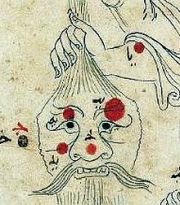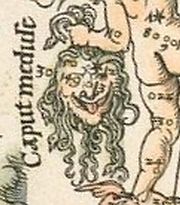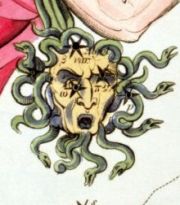Wikipedia
R.H. Allen:
Star Names
Ian Ridpath:
Star Tales
Uncharted
Constellations
SkyEye
|
Wikipedia |
R.H. Allen: Star Names |
Ian Ridpath: Star Tales |
Uncharted Constellations |
SkyEye |


|
|
Star LoreCaput MedusaeThe Head of the Medusa |
|


|
Caput Medusae is an asterism within the constellation Perseus that is sometimes seen as an independent constellation.
|

In Greek mythology, Medusa was one of the three Gorgons,
winged women with hair made of living venomous snakes. Looking into Medusa's eyes would petrify a person.
 Being the only mortal of the three Gorgons, Medusa was eventually killed by Perseus, who used his Harpe Sword to cut her head off.  Even in death, Medusa's eyes still had petrifying powers and Perseus carried her severed head as a weapon. In early versions of his fight with the sea monster Cetus, Perseus used the Harpe Sword. But in later versions (around the 2nd century AD), Perseus uses Medusa's head to petrify Cetus.  Perseus' bride Andromeda had previously been engaged to her uncle Phineus. When Phineus showed up at Andromeda's and Perseus' wedding, claiming older rights, Perseus let him look at Medusa's head, which turns Phineus into stone. |
 Perseus and Caput Medusae, Corbianus Thomas, 1730
Perseus and Caput Medusae, Corbianus Thomas, 1730Source: alteagallery.com
|

Later, he used Medusa's petrifying stare to turn Atlas,
the last Titan into stone.
 For as long as mythological figures have been depicted in star maps, Perseus can be seen with Medusa's head in his left hand (see examples below).  The asterism consist of the stars β, π, ρ and ω Persei. All of their names are directly related to the Medusa myth: Algol (β Per) is derived from the Arabic raʾs al-ghūl - Head of the Ghoul. π, ρ and ω Per bore the traditional Latin names Gorgonea Secunda, Gorgonea Tertia and Gorgonea Quarta. |

|
Sources: Wikipedia, Ian Ridpath,
John C. Barentine: Uncharted Constellations
There has never been a consensus on how to classify Medusa's Head - as an asterism, or as a constellation.
|
 Hevelius / Barentine
Hevelius / Barentine
|

 Leiden Aratea
Leiden Aratea816 |
 Book of Fixed Stars
Book of Fixed Stars964 |
 Poeticon Astronomicon
Poeticon Astronomicon1482 |
 Dürer
Dürer1515 |
 Pergamenthandschrift
Pergamenthandschrift15th Century |

 Hand Colored Uranometria
Hand Colored Uranometria1641 |
 Harmonia Macrocosmica
Harmonia Macrocosmica1641 |
 Atlas Coelestis
Atlas Coelestis964 |
 Uranographia
Uranographia1801 |
 Uranias Mirror
Uranias Mirror1824 |

|
Back to Star Lore |
Back to Mythology |
Back to Space Page |
Back to English |
 Back to Start Page |